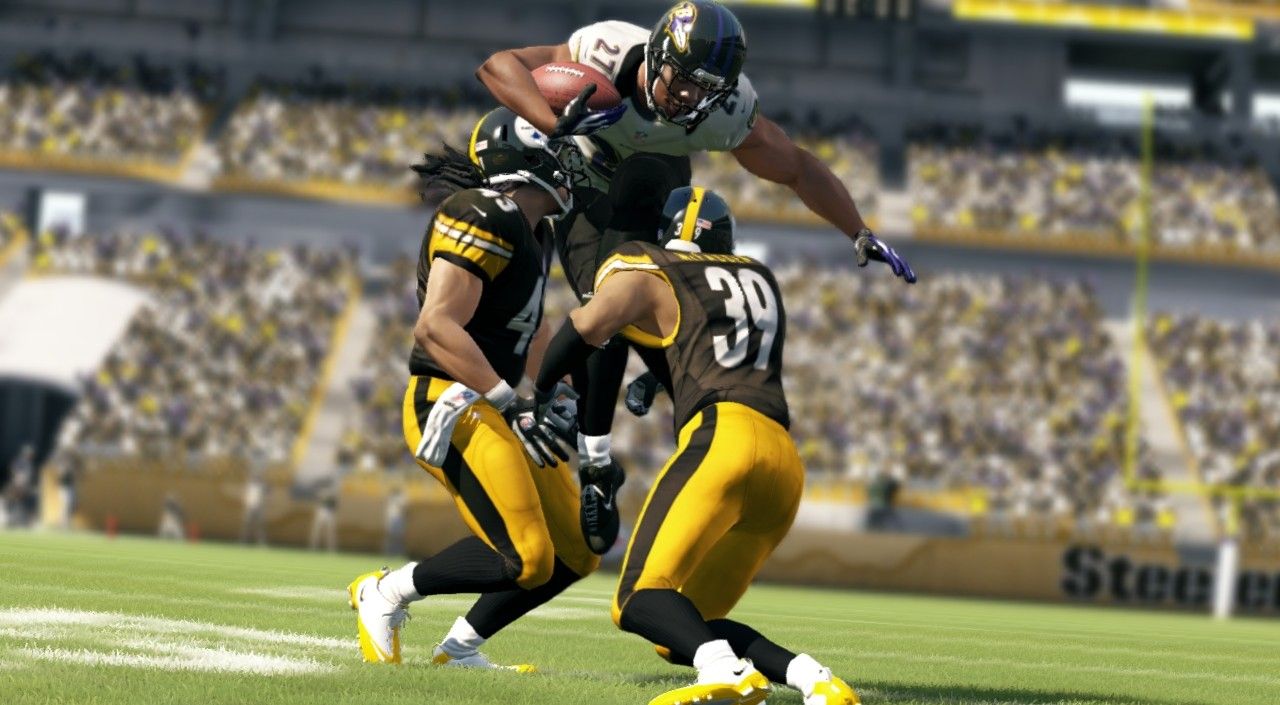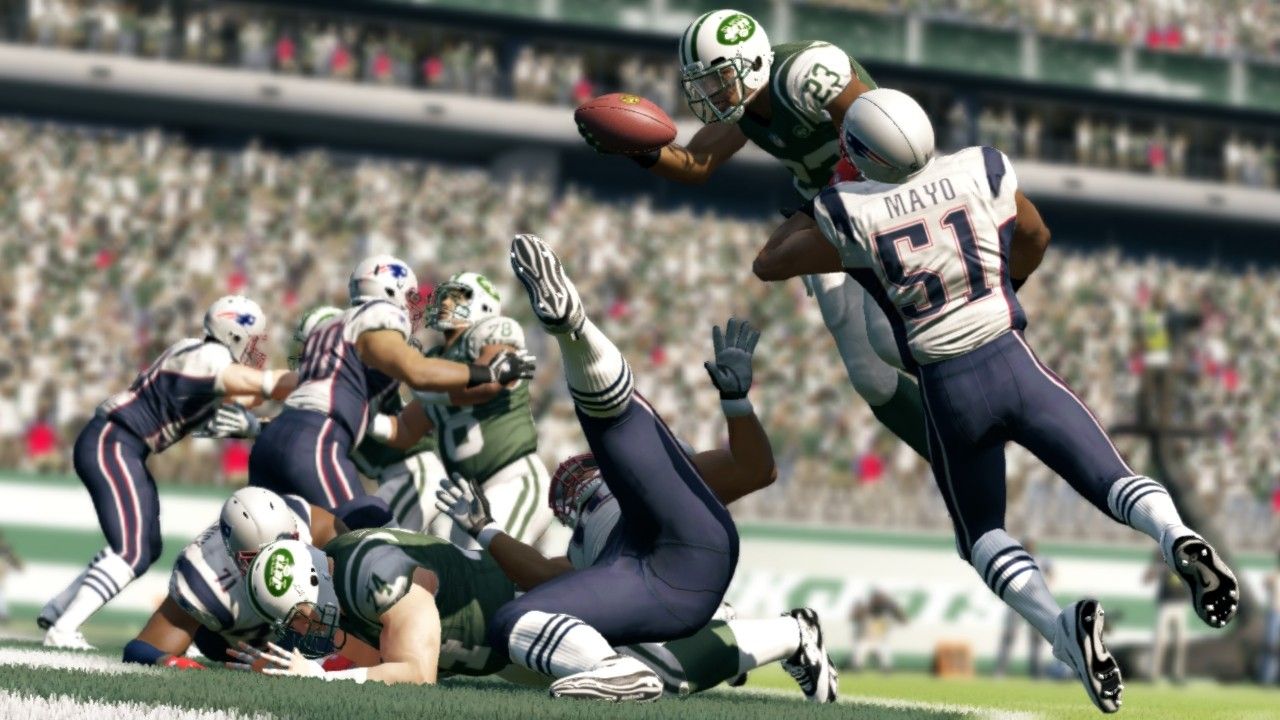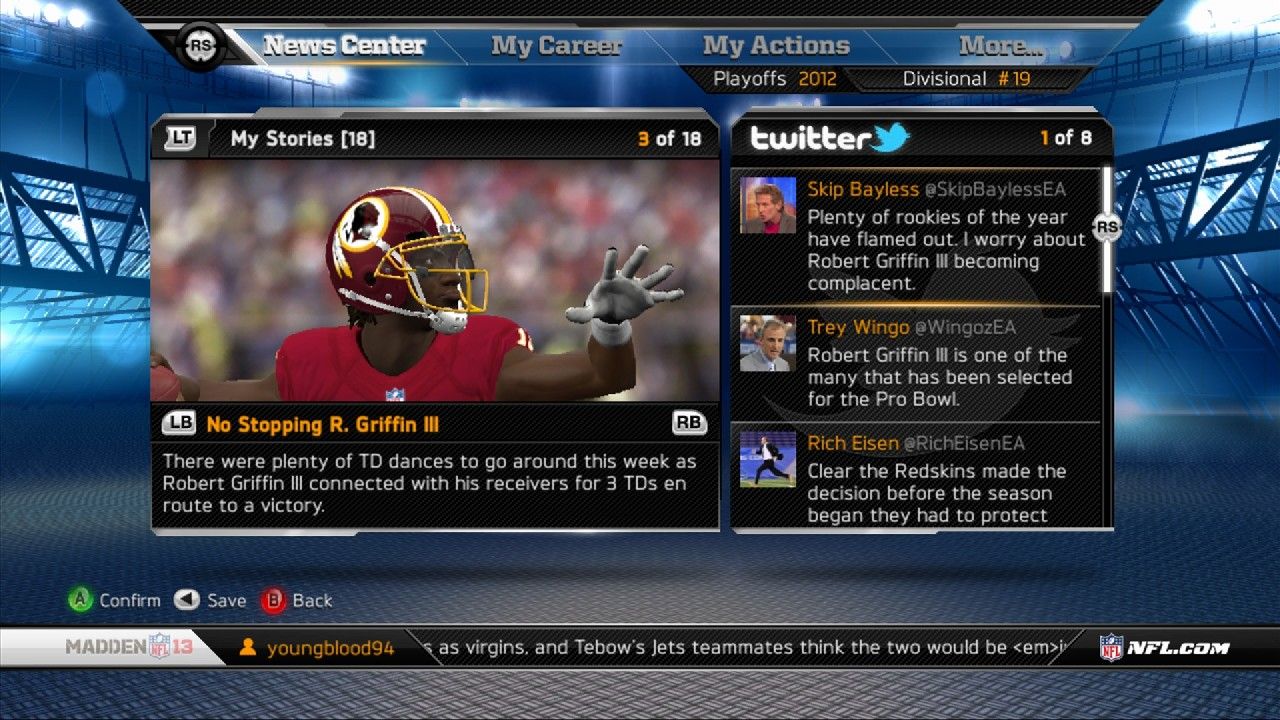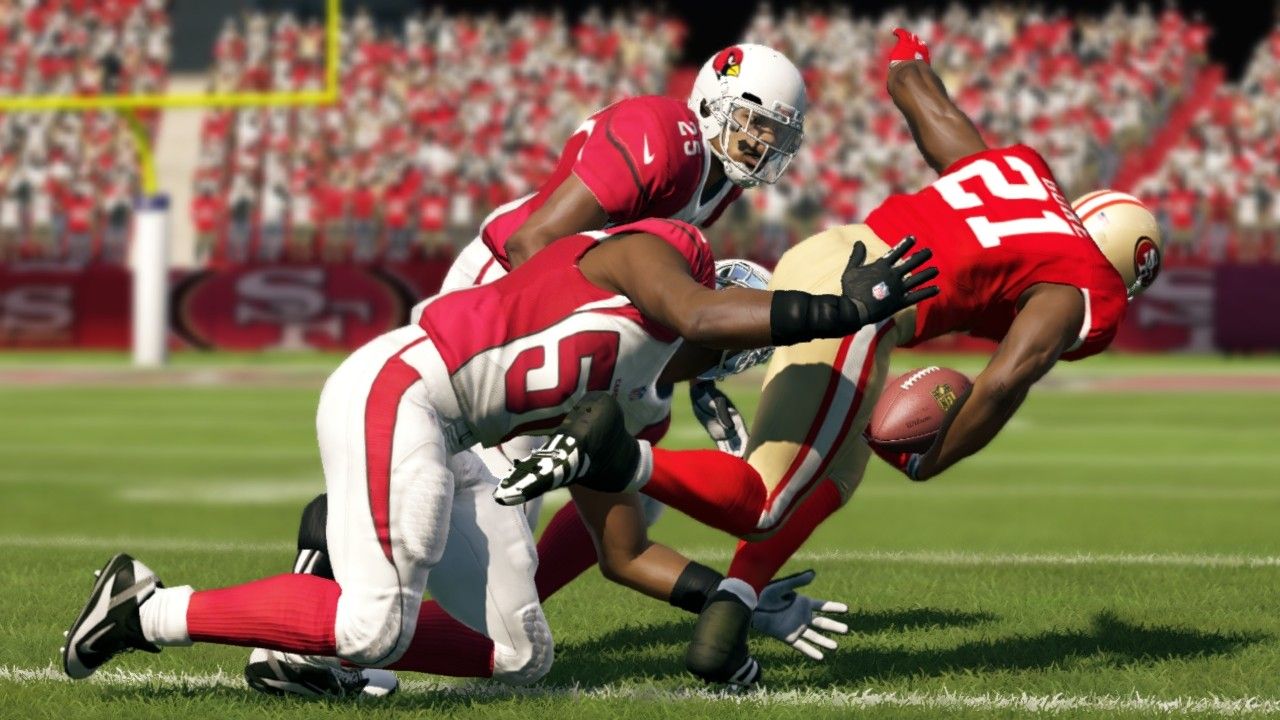Madden NFL 13 Review
Well, before helmet-to-helmet contact was banned, that is. Still, collision is the core of football. Bodies, minds, wills… all butting against each other, vying for position. When two such forces meet, unpredictability is the yield, and that’s what makes football so compelling. And so it stands to reason then, that the Madden NFL series would make capturing this dynamism priority number one. But though the franchise has always purported to be the definitive football simulation, its yearly entries have always had an air of determinism about them that’s seldom found in the real game. Technical limitations and an inside-the-box design philosophy combined to hinder the development of Madden’s internal mechanisms. And so, when the game’s engine was asked to respond to on-field happenings, its outputs frequently came off as stilted and familiar.

Those outputs came in the form of a limited set of canned animations and commentary. Combine such flaws with Madden’s exhaustive repository of player statistics, and you’d be forgiven for thinking that the game was inclined to just do what its metrics told it to, irrespective of your participation. Who wouldn’t furrow their brow the dozenth time their pass ricocheted inexplicably off a player’s hands, the commentators chiming in helpfully with the same quip that you heard two plays ago? In the face of such obstacles to enjoyment, and under the steady barrage of an annual release schedule, ennui would be an expected reaction for most gamers. Madden’s needed some big changes for a while now. That’s what makes this year’s version, with its new “Infinity” engine, such a breath of fresh air. Madden 13 contains a smattering of additional new features, but it’s Infinity, by and large, that really changes the experience. The new physics system injects life straight into the game’s core, and takes a big step towards revitalizing the tired franchise in the process.
That’s not all apparent when you first turn the game on, however. Madden has a well-deserved reputation for following a step forward with another step right back, and that tendency is on display right from the get-go here. Gone is the obnoxious cocktail of popular music (replaced with NFL Films-esque audio that’s pleasant, if a little vanilla). But one viewing of the game’s overly-long and melodramatic introduction will dispel any notions that Madden has lost its showy bravado and preoccupation with presentation aspects you care the least about. A commendable job has been done consolidating the various game modes into a more manageable package, but the interface buries any earned goodwill underneath a pile of redundant menus and saving systems. We’re all used to this sort of horizontal movement from the Madden franchise. EA Sports struggles to parse out which features should remain through subsequent iterations, and which areas could do with improvement. Another casualty of the annual release schedule, perhaps.

It’s a tendency that carries over through all features, from game modes and menus to on-the field action. Franchise mode returns, now under the comprehensive “Connected Careers” umbrella, which can support 32 players competing as players or coaches. But it’s difficult to tell if options that you select in one menu affect those of the Career Mode. Some menu sliders don’t appear to work at all. Create a Player is still there, along with its myriad sock customization options, but Create a Team, sadly, is still just a forgotten relic. There’s a sort of card game in the form of “Ultimate Teams” that’s an enjoyable diversion, and the usual set of online matchmaking options make an appearance. Commentary is generally improved by the more natural-sounding play-by-play of Jim Nantz and Phil Simms, but issues of repetition and curious calls persist. And for as smooth as the action typically looks, player models are beginning to look fairly dated, and in-game advertising remains stubbornly present. It’s give and take.
Madden 13 follows that trend in the majority of its package, but the lone exception comes where it matters most. We’ve all heard it said that gameplay is paramount, and if there’s any truth to that, then it’s certainly with sports games. Thus Infinity engine bears a heavy burden, even before considering that it’s the only major renovation on the offering. Luckily, the new engine is up to the task. For anyone tired of seeing their running backs magnetically pulled into generic tackle animations, or watching as their linebackers bounce off of ballcarriers ineffectually like so many electronic football table pieces, the new system is a boon. Infinity does a strong job of simulating lifelike limb movement, inertia, and yes, collisions. Tackles have taken a big step up in believability, incorporating factors like speed of players, positioning, and user inputs with realistic flair. Gang tackles are finally realized, and line play feels a bit more tangible, as well. One disclaimer: the physics engine may look great while plays are going on, but afterwards they often devolve into a comical mess of pratfalls and flailing limbs as the players trip on every bit of anatomy they graze.

That aside, I can’t say enough about the effect that the new physics have on Madden’s gameplay. There’s real glee to be had in watching your players struggle out of arm tackles, or seeing them bat a ballcarrier around in a vicious gang tackle. But Infinity’s truest achievement is a new sense of player agency. It’s a subtle effect, but after a little playing time you’ll begin to appreciate how subtle inputs can now more realistically modify on-field outcomes. Get a bit more space from a defender, and you’ve got a better shot to stiff-arm him into the turf if he makes his move too early. Get into the secondary with a head of steam, and defenders will have a tougher time bringing you down, (especially after a well-timed truck or spin move).
The Infinity engine gives the impression of divorcing play from the rigid metrics that govern things behind the scenes, striking a great balance between empowerment and unpredictability. Consequently, Madden 13’s exhaustive repository of stats and random number generators seem like less of a factor. Though that effect may be illusory, it still helps immersion immensely. You’ll come to the edge of your seat hoping that your running back can shed a third consecutive tackler. If he does, it’ll seem the result of his physical actions, rather than a computer’s algorithm. That’s a coup for players, and Madden 13 deserves praise for it.

Yet there’s no completely getting away from the statistics, of course. They’re ubiquitous, even if you’re not interested in number crunching to maximize your skill set. They come to the fore with created players, where control of franchise management options are ceded to the AI. The computer is a ruthless coach, as it turns out, doggedly adhering to the cold logic of its own player ability stats in the face of the evidence of on-field performance. Take this example: when Jahvid Best inevitably went down with an injury late in the season, 2nd year running back Nick Capozzoli finally got a chance to shine. He made the most of it, rushing for three touchdowns and catching another two, as the lowly 3-11 Lions went on to smoke the division-leading Bears in a surprise win.
You might expect such a performance to win young Nick a chance at the starting job. Or at least a role as a plow-share or changeup back, considering Best’s injury history, and the Lions’ playoff irrelevance. But no, Best returned to the lineup the following week, and Nick, the handsome and highly-touted first-rounder returned to punt return and equipment-fetching duties. For his efforts, he earned a handful of experience points, which were used to bump up his pass-catching abilities by a point. But the one point lead that Best has in his overall ability number seems insurmountable. Nick won’t be starting any time soon, unless he games the system or resorts to Nancy Kerrigan-esque methods.

Things are even worse if you opt to play as a lesser prospect. I didn’t find it realistically possible to create a lowly, undrafted player and move him up the ranks, even though the game poses it as an option. Sure, you can simulate through the games where you’re riding the pine, but in order to improve, you’re still going to have to practice. Yet practicing isn’t as fun as it’s been in previous entries, largely due to how closely it resembles the experience of Madden’s regular gameplay.
Weekly practice presents an opportunity for Madden to break up the wearying incessancy of the march to the playoffs. Sadly, by closely following the game formula, it feels redundant, to the point that playing a few consecutive weeks of career mode can feel like a chore. No doubt the intent was to have practices double as both a roleplaying feature and a training mode for users, but the execution is pedestrian. Earlier entries did a better job of drilling nuanced techniques for those holding the controller, and this year’s iteration could do more to injecting interest into the feature. There’s certainly potential here, but Madden still hasn’t seized upon it. As far as roleplaying in practice goes, I’ll grant Madden this: much like a real player, you’ll be tempted to skip it. Doing so means missing out on experience points, however. Points can be applied to any of your player’s many esoteric stat categories (toughness, accuracy, clutch rating, etc.), or used to gain special skills like getting both feet inbounds after a catch. They’re your best shot at taking over a starting role outside of the injury bug, and if you’re not getting them in at gametime, then practice is the only place to earn them.

For a player with a mediocre skill set, that can mean season after season of running through rote drills and waiting idly through games. It’s realistically mind numbing, I suppose, but Madden 13 needs to make the option more interesting to warrant its inclusion. I’d love to see EA go further with its RPG flirtations here. Really, the NFL’s most compelling drama isn’t in the predictable successes of its elite players; it’s in the day-to-day struggles of those trying to break in to the league, or hold down a job against stiff competition. It’s why HBO’s Hard Knocks makes for such great viewing. I’m not asking for Madden to replicate that experience (not quite yet, at least), but the game should at least step out of the way of players who want to create their own such narratives. A little effort here could go a long way, as demonstrated by the efficacy of similar and well-executed features like the new simulated twitter feed or live draft.
As things are, Madden still has an uncomfortable relationship with such roleplay. It’s an odd hangup for a game focused on myriad personal stats, with 24 different arm equipment options, and a card collecting mode. That’s a strange sort of cognitive dissonance, like a jock who can’t reconcile his appreciation of twelve-sided dice.
